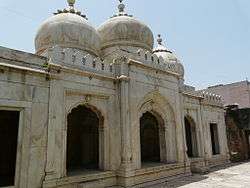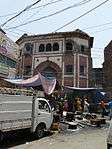Zafar Mahal (Mehrauli)
| Zafar Mahal | |
|---|---|
 Zafar Gate of Zafar Mahal | |
 Location within India | |
| General information | |
| Architectural style | Mughal Architecture |
| Town or city | Delhi |
| Country | India |
| Coordinates | 28°30′57″N 77°10′39″E / 28.5158°N 77.1775°E |
| Completed | 19th century |
| Demolished | Ruins |
| Client | Mughal Dynasty |
| Design and construction | |
| Architect | Akbar Shah II and Bahadur Shah Zafar II |
Zafar Mahal, in Mehrauli village, in South Delhi, India is considered the last monumental structure built as a summer palace during the fading years of the Mughal era. The building has two components namely, the Mahal or the palace, which was built first by Akbar Shah II in the 18th century, and the entrance gate that was reconstructed in the 19th century by Bahadur Shah Zafar II, popularly known as “Zafar” (the nom de plume of Bahadur Shah II) meaning ‘Victory’. It has a forlorn history because Bahadur Shah Zafar who wished to be buried in the precincts of the Zafar Mahal (palace) and the famous Dargah of Khwaja Qutubuddin Bakhtiar Kaki in Mehrauli, Delhi, but deported by the British to Rangoon, after the First War of Indian Independence in 1857, where he died of old age without any honour.[1][2][3]
History
Zafar Mahal, is the ruined summer palace of the last Mughal Emperor, Bahadur Shah Zafar II. The Moghul Dynasty, which started with the first Mughal Emperor Babur who conquered Delhi in 1526 AD ended after 332 years when on October 7, 1858 the last Emperor Bahdaur Shah Zafar II (1837–1857) was tried for treason by the British and deported to Rangoon, Burma, now Myanmar from the imperial city of Delhi. The irony of this history is also that he travelled in a bullock cart, with a group of British Lancers escorting him.[3]
The graves in Mehrauli in the precincts of Zafar Mahal, built within a marble screen enclosure by Jahandar Shah for his father Bahadur Shah I and others who followed, is a minor reflection of the history of the place. Shah Alam II who had the misfortune of being blinded by Ghulam Qadir, the Rohilla leader was buried here. He was considered a "puppet ruler", first under the Marathas and later under the British. His son Akbar Shah II was also buried here. Mirza Fakruddin son of the last emperor Bahadur Shah Zafar, who died early ushered the end of the Moghul regime, was also buried here. But Bahadur Shah Zafar who had identified the location for his grave (sardgha – the vacant land for burial) was the most unfortunate (ill fated) as he was deported to Rangoon and was buried there.[4]
The exiled emperor died in November 1862. He was buried with great urgency in the night itself with “lantern light” in presence of his few family members under the direction of a British officer. The grave was initially unmarked but later a Tablet was erected at the location but only in the 20th century. His mazar (grave) has at last become a shrine and the local Burmese and also visitors from India and Pakistan consider him a Pir (saint). It is also said that the nationalist leader of India, founder of the Indian National Army, Subhas Chandra Bose took a formal oath at this grave to free India from foreign rule.[5]
Structure


The palace, located at about 300 feet (91 m) to the west of Ajmeri Gate of the dargah of Khwaja Kaki has an imposing gate. It was built in 1842 by Akbar Shah II. Built as a three-storied structure in red sandstone embellished with marble, it is around 50 feet (15 m) wide with a gate opening called the Hathi gate (built to allow full decorated elephants with the howdah to pass through) is of 11.75 feet (4 m) opening at the entrance. An inscription on the main arch credits building of the gate (as an entry gate to the existing Mahal) by Bahadur Shah II in the eleventh year of his accession as Emperor in 1847-48 AD. A broad Chhajja (cantilevered projection) built in the Mughal style is a striking feature of the arch. At the entrance gate, the logo has small projecting windows flanked by curved and covered Bengali domes.[1][2][6] On both sides of the arch, two ornate medallions in the form of large lotuses have been provided.[7] The gateway also depicts a classic tripolia or three-arch opening into the baaraadaree or 12 opening structure, which fully draws the breeze. In the top floor of the palace, there is multi chambered dalan (arcade room with one open side overlooking a courtyard), considered the Indian part of the structure, which has terrace on the palace side and with a view of the entrance at the other end. European type of structures of 19th-century vintage are also seen in external decorations, which are not very pleasing. A fireplace is also seen on an inside wall, identified as a European addition to the palace.[4][7]

A masjid (mosque) called the Moti Masjid (pearl mosque), built by Bahadur Shah I (d.1712), was a private mosque of the royal family, which has now been subsumed within the palace precincts. The mosque is a small and unique three-domed structure made of white marble. Its construction is also credited to Bahadur Shah. The austere mosque has the mihrab on the west direction of prayer but is unusually not embellished, except for little border of floral carving on the south at the top edge of a dado.[4][7]
The Chhatta Chawk or vaulted arcade design of the Lahore gate at the Red Fort in Delhi has provided the basic design that was replicated for the Zafar gate. It is a large covered passage (arcade) with arched apartments on either side. The arcade, which has rooms within its enclosures, located just after the entrance of the gate, is two directional; one runs towards south, and the other is to the east. The palace, situated a few steps down the arcade, is now in a dilapidated condition. Its restoration is limited by the inadequate documents to deduce the original construction details. The Archaeological Survey of India document titled “List of Mohammedan and Hindu Monuments” of March 1920 provides only sketchy details.[1][6][7]
Every year Bahadur Shah Zafar used to visit this palace for hunting during the monsoon season. Also, every year, he was honoured at this palace during the Phool Walon Ki Sair (procession of the "Flower Sellers") festival held in February/March.[8]
Conservation

It was declared a protected monument in 1920 under the Ancient Monuments Preservation Act, 1904, but is now encroached with new structures built on parts of its southern and eastern walls.[1] The Indian National Trust for Art and Cultural Heritage (INTACH) has also listed this monument as a conservation area.[9] Now, as a part conservation activity of heritage monuments, the Archaeological Survey of India (ASI) has proposed to set up the Mughal Museum in this palace with the intention of encouraging visitors and also to ensure removal of extensive encroachments (see photo in gallery below) that have taken place in the precincts of the old palace. ASI considers that the Museum would be a tribute to the legendary last Mughal emperor Zafar who was known more for his poetry than his administrative achievements.[10]
Poetic pathos
Bahadaur Shah Zafar who was known as the poet-king wished to be buried next to graves of his predecessors Bahadur Shah I (1701–1712), Shah Alam II (1759–1806), Akbar Shah II (1806–37) and their families at sardgah[11] or grave in the marble enclosure adjoining the dargah of the 13th century Sufi saint, Qutbuddin Bakhtiyar Kaki in the Zafar Mahal precincts. He had special attachment to this place in Mehrauli, particularly with the tomb of Qutb Kaki, the Sufi saint of the Chisti order as he was his mureed (disciple).[5][12]
After he had been deported, while in Rangoon (now called Yangon) prison, Bahadaur Shah Zafar penned his couplet known by the title "do gaz zameen" meaning two yards of land, lamenting for his fate of not finding a place for his burial (at his chosen place of burial) in his home country. The couplet reads in Urdu language as:[9][12]
Kitna hai badnaseeb Zafar
Dafn ke liye
Do gaz zameen bhi
Mil na saki kuye yaar mein
English translation:
How unlucky is Zafar! For burial, even two yards of land were not to be had in the land of his beloved.
Just before he died, he wrote some more ghazals (couplets), which are touching for the pathos they convey.[5]
It is now, therefore, probably an appropriate time that a suitable memorial is erected at the vacant burial place he had chosen in the precincts of Zafar Mahal.[5]
Access
Mehrauli village in South Delhi is well connected by a good road net work and it is also part of the Qutb complex, which is a favourite visitors destination. New Delhi International Airport is 17 kilometres (11 mi) from Mehrauli. The nearest rail head is New Delhi Railway Station, which is 18 kilometres (11 mi) by road. But within Mehrauli, finding Zafar Mahal in the labyrinth of narrow streets of the village needs direction and landmarks. The tomb of Adham Khan is a much visited place and from here after crossing the main road and walking through a narrow lane reach Hazrat Qutubuddin Bakhtiar Khaki’s shrine (a popular Muslim pilgrimage centre). From this shrine, walking barefoot after passing through twisting lanes reach Moti Masjid and the Zafar Mahal complex. The small marble enclosure on the right of the Masjid houses the graves of some of the Mughal emperors and also the vacant grave of Emperor Bahadur Shah Zafar.[5]
Gallery
 A domed pavilion in the courtyard of Zafar Mahal
A domed pavilion in the courtyard of Zafar Mahal Ruins of the Palace
Ruins of the Palace Dalan over Naubat Khana of ruined palace
Dalan over Naubat Khana of ruined palace Zafar Mahal, Naubat Khana showing the surrounding encroachment
Zafar Mahal, Naubat Khana showing the surrounding encroachment
References
- 1 2 3 4 Abhilash Gaur (1999-11-07). "Zafar Mahal: A forsaken monument". The Tribune. Retrieved 2009-07-22.
- 1 2 Y.D.Sharma (2001). Delhi and its Neighbourhood. Dargha Qutb Sahib. New Delhi: Archaeological Survey of India. pp. 62–63. Retrieved 2009-07-25.
- 1 2 William Dalrymple (2006-10-01). "A dynasty crushed by hatred". Telegraph.co.uk. Retrieved 2009-07-22.
- 1 2 3 Lucy Peck (2005). Delhi - A thousand years of Building. Palace. New Delhi: Roli Books Pvt Ltd. p. 225. ISBN 81-7436-354-8.
- 1 2 3 4 5 Ronald Vivian Smith (2005). The Delhi that no-one knows. Zafar Mahal and Sardgha. Orient Blackswan. pp. 14–15. ISBN 978-81-8028-020-7. Retrieved 2009-07-24.
- 1 2 "Hathi Gate and Zafar Mahal". Retrieved 2009-07-22.
- 1 2 3 4 "Zafar Mahal and Moti Masjid: From Many Bygone Eras...". Retrieved 2009-07-22.
- ↑ Patrick Horton; Richard Plunkett; Hugh Finlay (2002). Delhi. Zafar Mahal. Lonely Planet. pp. 127–128. ISBN 978-1-86450-297-8. Retrieved 2009-07-24.
- 1 2 Mandira Nayar (2002-12-17). "Concrete jungle threatens to `usurp' Moghul monument". The Hindu. Retrieved 2009-07-22.
- ↑ "ASI To Build Mughal Museum At Zafar Mahal". Retrieved 2009-07-22.
- ↑ "Sardgah and Zafar's Last Wish". Retrieved 2011-09-04.
- 1 2 Alokparna Das (2008-11-02). "Retreating into the Sufi's shadow". Indian Express. Retrieved 2009-07-22.
External links
![]() Media related to Zafar Mahal (Mehrauli) at Wikimedia Commons
Media related to Zafar Mahal (Mehrauli) at Wikimedia Commons